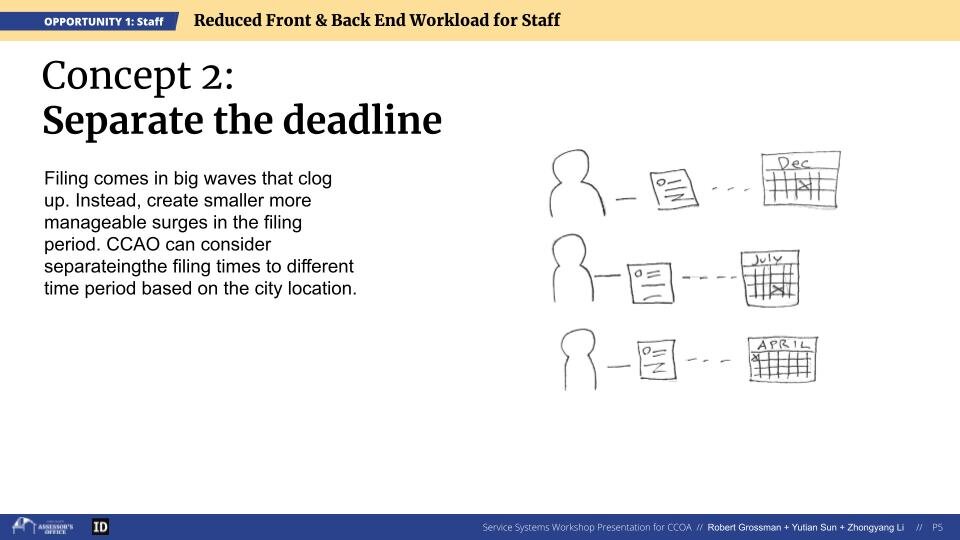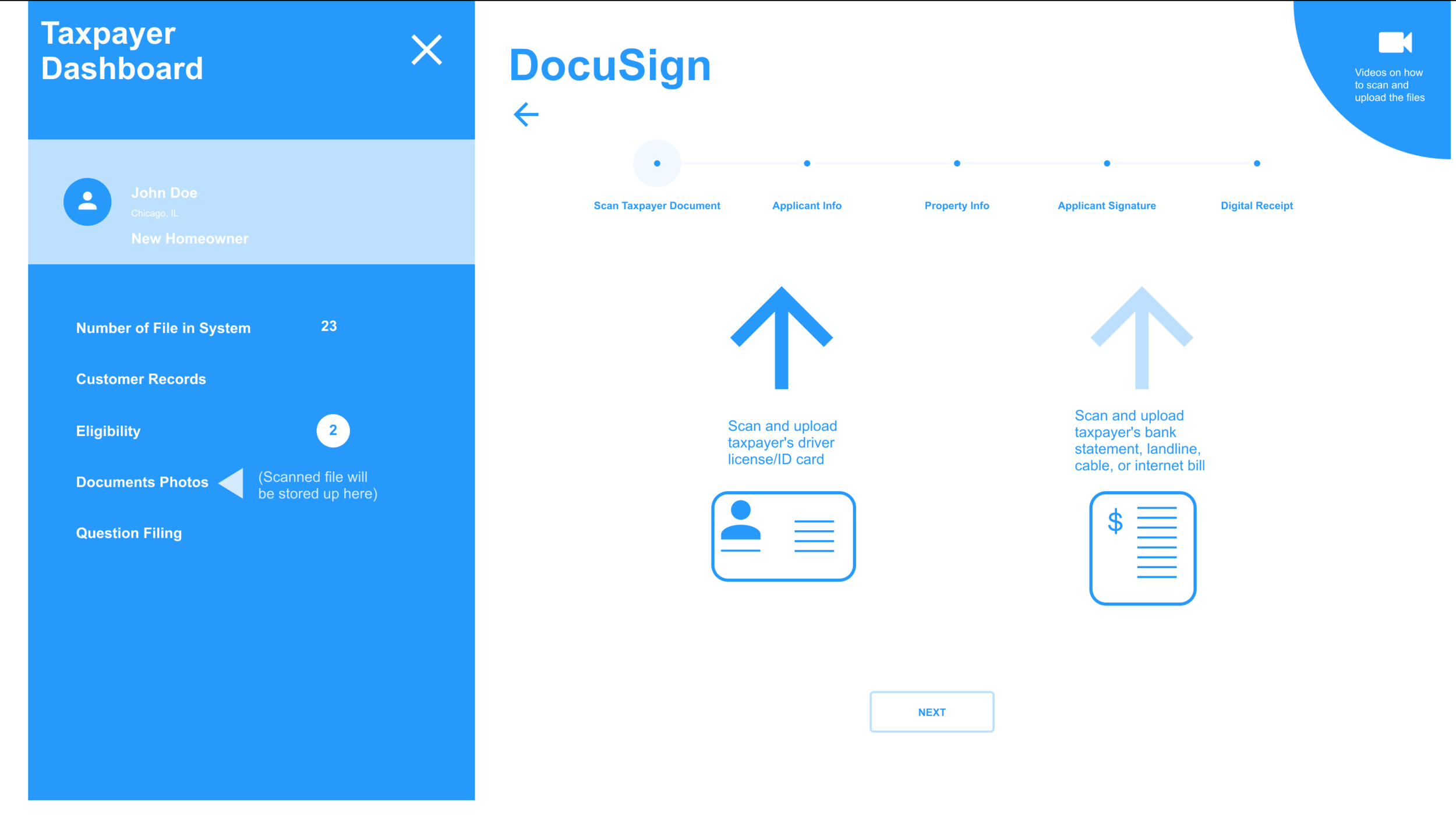Robert Grossman
I Help Organizations Make Better Informed Decisions
Developing Partner-Led Services
Reducing Calls and In-Person Visits While Increasing Transparency
Trust, Money, and Transformations
THE CHALLENGE
The Cook County Assessor’s Office (CCAO) is responsible for determining property taxes and exemptions. It can get upwards of 300-600+ visitors a day during the busy periods at each of their three locations. These offices are run by a small veteran staff and lead by the elected Assessor, Fritz Kaegi. The office has been working hard to implement more transparent practices and we were brought in by the Assessor in an effort to help out the office as it worked through the transition of moving processes to digital format and a redesign of its space. We were handed us off to his staff, who thought we were going to come up with new colors for the walls and help them rethink how the desks should be positioned. With a very busy complex government staff, we had limited access, so we had to make the most of each engagement. Then the pandemic hit and we all went remote.
“The Assessor’s Office website makes sense for the office, not for grandma and online filing is a pain for taxpayers and staff alike.”
Digital Transparency Hidden by Digital Transformation
Insight to Opportunity
After an initial visit to discuss the project, we broke off into research teams. With my team I developed interview guides and I chose the empathy map and AEIOU frameworks for our team to use to record our data into. Armed with these, we visited the three Assessor’s office locations around Cook County and conducted employee interviews, taxpayer intercepts, and observations. From the data we gathered we identified the main touchpoints and built journey maps. My team’s was created in Google Sheets for ease of collaboration since my team members did not have digital whiteboard experience. I performed a SERpICo behavioral analysis to understand some of the decision-making and technology that staff deal with. I also did a paper flow analysis to understand how tax exemptions were received and filed.
We learned that the Cook County Assessor is an elected official, but the majority of the staff have been there for 15+ years and take pride in being able to help people save money on their taxes. A number of taxpayers liked to come in and have one-on-one help with their filing. While there is a general distrust of the Assessor’s office due to past history, most people who come into the office walk away happy with their experience with the staff. Our initial insights were:
Insights:
1) Existing information does not sufficiently empower individuals to take action on their own.
2) Property owners seek transparency and access to their filed appeals and exemption status.
3) CCAO has earned Property Owner’s trust through physical interactions but other touchpoints lack the same accessibility.
We found four main areas where we could make the most impact - the physical space, orienting people, the exemption process, and the appeals process.
“Taxpayers have redundant questions or concerns about the exemption filing process and information about how and what to file are not transparent, especially while waiting for the acceptance of filing.”
Gotta Get Granny Onboard
Insight to Action
I was part of the team that focused on making an impact through the exemption process. There are a number of different exemptions available to select populations of homeowners. These can save a homeowner several thousand dollars a year. Through some analysis found that the filing process was pretty much the same for everyone and that led us to look at the three key moments and then attaching relevant research data to each. Analysis of the CCAO digital interface showed a lack of informational hierarchy. From this data, we determined there were two main areas of insights:
1) Taxpayers have redundant questions or concerns about the exemption filing process and information about how and what to file are not transparent, especially while waiting for the acceptance of filing.
2) The Assessor’s Office website makes sense for the office, not for grandma and online filing is a pain for taxpayers and staff alike.
We asked ourselves why can't we make the online experience as clear, easy, and pleasant as visiting the office? Realizing that CCAO was understaffed and overburdened we also asked how could we make their lives easier? That’s what we based our initial concepts around. Working both synchronously and asynchronously on these we saw patterns begin to emerge. Doing this remotely during a pandemic was tough at times. We set achievable tasks for ourselves and blocked out times for collaborative work. We arranged our recommendations by feasibility and shared them with the client team along with analogous benchmarks from other industries. That discussion led to us beginning to develop two partner-led services, something they said they had been trying to figure out for a while.
Build & Test in the Rona
Development & Prototyping
With CCAO’s approval, we began to flesh out what each service would look like. This started with building service blueprints. My role was not only creating them but also pushing to make them as easy to understand as possible for the client team. We continued to look at analogous benchmarks, like blood drives as pop-up experiences. Once we had a solid idea of the service, I created initial storyboard sketches to get on the same page about what the services would look like and visualize the various touchpoints and stakeholders. My team members worked on the apps’ UI while I prototyped the service experience for pop-up exemption filing. Because the pandemic had eliminated prototyping on location, I built a model of a standard Chicago public library and role-played going there to file as a means of discovery. It led to the realization that wayfinding signage, scheduling, and access to a scanner were critical, as well as where critical breakpoints were.
Having developed some initial prototypes, I reached out to realtors to test our ideas, learning that paper brochures needed to be digital, helping homebuyers save money helped agents provide a better customer experience, and that title agencies were another avenue. I also set up user-testing on the exemption filing digital product, providing the team an opportunity to see how the user experience holds up in context.
Some of my other roles on the team were visiting possible locations of service delivery to research proof-of-concept, developing a clear and compelling pitch narrative, weaving humor and attitude into our materials to help make data more memorable, presenting, and engaging with the client teams.
Digital On-boarding with In-Person Hand-holding
THE RESULT
My team produced two kits for use with external partners to help reduce the number of in-person visits and calls to the call-center. These were directly tied to CCAO’s goals of increased new homeowner exemption filing, transparency, and adoption of its online filing processes.
One kit is for use by realtors to schedule property tax exemption filing for first-time homeowners during the closing on their new home. The kit consists of a web app that walks real estate agents through a scheduling process, digital/printable brochures for both the new homebuyers and realtors explaining the process and its benefits. This quick scheduling can save buyers a couple of thousand dollars a year which can equate to more customer satisfaction for the agents!
The other kit is for pop-up filing centers in neighborhoods around the county. It consists of a web app that walks users through the exemption filing process, questions and conversations to have with filers, directions for set-up, and printable signage. This was developed to be piloted with librarians since they consider themselves sources of help and information. By spreading the office visits across a number of localized pop-up filing centers, the spread of COVID-19 could be better controlled while still providing in-person assistance to the homeowners who need it and relieving some of the pressure on CCAO’s staff during the busy season.































